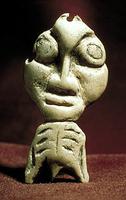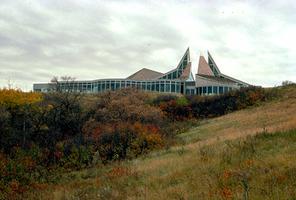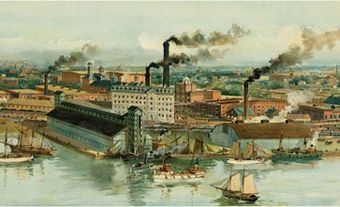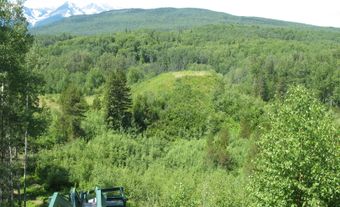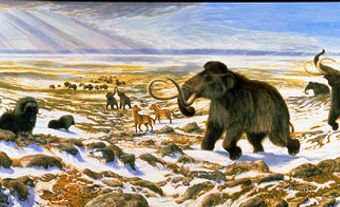Archaeology
Archaeology is a historical science aimed at the discovery and understanding of past human behaviour through the study of material remains. Unlike conventional history, it does not limit itself to written documents as its primary source of data. While archaeologists may well use such documents and, indeed, oral histories as well, the bulk of their information is drawn from physical remains left at locations where people lived, worked, visited and were buried long ago. As a result, archaeology is able to investigate not only the recent past and subjects to some degree already documented, but also epochs beyond the reach of memory and before the spread of writing.
The archaeological record is sometimes divided into historic and prehistoric periods, depending on the availability of written sources. In Canada, the prehistoric record extends back as much as 30 000 years (see Prehistory) in unglaciated portions of the northern Yukon. The historic period is normally dated from the arrival of Europeans, a few hundred years ago, to the present. The transition from prehistoric to historic was not always a sharp one, however, and in many cases European goods and influences (sometimes including diseases) penetrated far inland through Aboriginal traders to distant Indigenous Peoples who had not yet seen Europeans. The time between European arrival and actual face-to-face contact is usually described as protohistoric. During recent years, in order to avoid misconceptions about dinosaurs and savage peoples that accompany the term "prehistoric" in popular conversation, many Aboriginal people and archaeologists have come to prefer the term "precontact" for the time before European arrival.
Archaeological remains may be as large as a town or as small as a bone bead, but are often limited to relatively imperishable artifacts made of stone or fired clay. In unusual circumstances such as dry caves, submerged sites and permafrost, remarkable cases of organic preservation occasionally occur. Features such as hearths, post-mold patterns, house structures, rock alignments, stone monuments, stone quarries, and pictographs and petroglyphs can also furnish important details about past dwellings, resource use and ceremonial-religious life. Burials yield information about mortuary practices, and often provide direct biological facts about ancient peoples themselves. Dietary practices can be reconstructed from faunal and floral remains. By careful study of such diverse remains, archaeologists are able to reconstruct many aspects of past economic, social, religious and political life.
An archaeological site is any locality where the material remains of ancient human activity are found. These can range from single isolated artifacts to kill-sites, tipi rings and more complex habitation places such as hamlets, villages, towns and fortifications. In Canada, our largest archaeological sites include the Fortress of Louisbourg, the Rainy River Burial Mounds, the drive lanes for Head-Smashed-In Buffalo Jump in Alberta, and some late precontact villages in southern Ontario and coastal British Columbia, which can measure many hectares in extent.
Archaeological sites are found either by accident or by deliberate systematic search. Much can be learned by simple unintrusive observation. However, investigation of buried sites usually requires controlled excavation where pains are taken to record the exact position of everything found, including soil context, artifacts and features. One of the field archaeologist's most important problems lies in determining the nature of a given site. Was it used only once (ie, a single component), or was the site occupied recurrently (ie, multi-component)? Was the occupation by the same or by different groups of people? And what were they doing?
The DATING of ancient sites is another difficulty. Radiocarbon analysis is one of the important dating methods used in Canada. During their lifetimes all living things take in carbon, which decays from one isotope to another at a known rate. By measuring the ratio of carbon isotopes in a piece of organic material such as wood or animal bone, it is possible to determine the death date of the once living organism, and thus, approximately, the age of the context within which it was found. Most archaeologists also rely on a comparison of the kinds of artifacts they find in sites to verify radiocarbon results, and to extrapolate those results to sites that have not been directly dated. Elaborate cultural sequences extending thousands of years have been produced for most parts of Canada.
Archaeological sites are a non-renewable resource, often our only avenue into a distant past not recorded elsewhere. They are protected from vandalism and unauthorized excavation by a range of provincial, territorial and federal laws and regulations. Throughout Canada, the location and nature of archaeological sites are recorded for management purposes using a site-designation scheme known as the Borden system, after Charles Borden, who first proposed it.
Archaeology in Canada
Training at the university level is usually obtained in anthropology departments, although two Canadian universities, Calgary and Simon Fraser, have departments devoted solely to archaeology. Archaeologists also reach across academic disciplines to collaborate with scholars in other fields such as geology, geography, biology, physical anthropology, palaeontology, chemistry, astronomy, mathematics, physics, history, sociology and ethnology. Professional archaeologists may be found in museums, universities, government research and regulatory agencies, and private consulting firms. Since the 1970s, the greatest growth in the profession has been in provincial agencies charged with cultural resource management programs and in commercial consulting firms vying for government and industrial contracts. There are also archaeological societies in every province that provide an interface for archaeological interests.
History of Canadian Archaeology
Beginnings to 1911
The origins of Canadian archaeology lie in early-19th-century antiquarianism, a time when the potential and methods for archaeology were being worked out. This pre-Confederation era was also a time of relic hunting when many sites, including Indigenous burial grounds, were destroyed for the exotic objects they might contain. Ontario's Niagara Peninsula stands out in this respect, for it was there that historic Neutral cemeteries were dug into as early as 1828, and some of the sites attained international fame. Such was the case for the Dwyer ossuaries north of Hamilton. Opened prior to 1836, Dwyer attracted many people including Sir Daniel Wilson. He was the first to articulate a scientific rationale and method for Canadian archaeology.
In 1842 Sir William Logan founded the Geological Survey of Canada in Montréal. The GSC produced many fine scholars with wide interests in natural history, Indigenous groups and archaeology. It also established Canada's first federal museum, a predecessor to the National Museums System.
After Confederation in 1867, interest in Canada's pre-European past developed slowly. East and West Coast shell middens continued to attract relic hunters, while conspicuous burial mounds in southern Manitoba and Ontario evoked speculations of a vanished race of "Mound Builders" with recognizable ties to the elaborate mounds of the Mississippi and Ohio drainages. In southern Ontario, desecration of Huron burial pits became sport for looters, despite pleas from concerned scholars. In Québec, concerted attention was paid to identifying Historic Sites, an example being Sir John Dawson's attempt to identify the site of Hochelaga at Montréal. In New Brunswick, Loring Bailey and William Ganong compiled information about known prehistoric and historic sites.
The post-Confederation era was one of intensive archaeological and ethnographic collecting. The making of photographic records also made a debut. Local naturalist, scientific and historical societies flourished. They stimulated provincial governments to establish museums and other educational programs promoting archaeology. Nova Scotia opened the first provincial museum in 1868 at Halifax, while Ontario and British Columbia sponsored formal museums in 1886. It was primarily from these milieus that the first generation of professional Canadian archaeologists began doing field work, describing and interpreting results, and setting research standards.
Notables such as T.G.B. Lloyd, William Gossip, Bernard Gilpin, Harry Piers, Spencer Baird, George Matthew, Henry Montgomery, George Laidlaw, Andrew Hunter, Frederick Waugh, Marvin Schultz, George Bryce, Charles Hill-Tout and James Teit all contributed to the early development of Canadian archaeology, but paramount among them was Ontario's David Boyle. A former blacksmith and public-school teacher, Boyle become provincial archaeologist in 1886, a post he held until his death in 1911. In 1886, he established the first journal in Canada expressly devoted to archaeology and ethnography, the Annual Archaeological Reports of Ontario. It continued publishing until 1928. Internationally renowned in Britain and the US, Boyle was an indefatigable worker widely revered as the leading figure in Canadian archaeology and museology.
1911-46: Development and Decline
The Ontario Provincial Museum was renamed the Royal Ontario Museum in 1914 and moved to new quarters. Rowland Orr became the second and last provincial archaeologist for Ontario, a position which lasted from 1911 until his death in 1933. However, it was two other individuals who dominated the second generation of professional archaeology in Canada. These were Harlan I. Smith and William J. Wintemberg, both of the Geological Survey of Canada Museum, later known as the National Museum of Canada.
Smith began a distinguished career as an assistant to Frederic W. Putnam of the Peabody Museum in 1891. In 1895 he joined the staff of the American Museum of Natural History, which brought him to British Columbia as a member of the Jesup North Pacific Expedition organized by Franz Boas. Following that, Smith joined the newly created Anthropology Division of the Geological Survey of Canada as Senior Archaeologist in 1911, a position he held until retirement in 1937. He began with plans for a systematic archaeology of the country to be followed almost immediately with excavation of a major site in each region. Wintemberg started his researches in southern Ontario as a protégé of Boyle in 1900 and, in 1912, joined the Victoria Memorial Museum in Ottawa as an assistant to Harlan Smith. Shortly afterward, Diamond Jenness, Canada's most distinguished anthropologist and a substantial contributor to arctic archaeology, also joined the Museum. As of 1912, Ottawa became the primary centre for a Canada-wide archaeology.
In southern Canada, Smith undertook surveys in British Columbia and Alberta in 1913; hired W.B. Nickerson to survey and excavate in the mounds region of southern Manitoba during 1912-15; worked with Wintemberg on surveys of eastern and southern Ontario in 1911-12, while they also launched the famous Roebuck site excavations, which lasted 1912-15. Also at an early stage, Smith and Wintemberg did surveys along the Ottawa and St Lawrence rivers in Québec. A Museum contractor, Frank Speck, discovered the Tadoussac site in 1915. Wintemberg and Smith surveyed and excavated in Nova Scotia during 1913-14, and Wintemberg did additional work in Nova Scotia, New Brunswick and Newfoundland in subsequent years.
Archaeological research in far northern Canada began as part of the Canadian Arctic Expedition of 1913-18. Vilhjalmur Stefansson and Diamond Jenness both undertook limited archaeological excavations in the western Arctic, while Jenness also studied the Inuit of Coronation Gulf (see Copper Inuit). In the eastern Arctic, professional archaeological ground was broken by Therkel Mathiassen, archaeologist with the Danish Fifth Thule Expedition of 1921-24. It was Mathiassen who laid the groundwork for the scientific study of arctic archaeology through his definition of Thule Inuit culture.
Questions about Inuit origins proved popular during this time, and Kaj Birket-Smith proposed his now defunct hypothesis of an inland origin for Inuit culture in north-central Canada. He and others were unsuccessful with such ideas because they attempted to solve an essentially archaeological problem with the data and techniques of ethnology. In 1925, Jenness made a major breakthrough with the analysis and definition of the ancient Dorset culture, which preceded Thule culture in the Canadian Arctic.
Between 1908 and 1912 public interest in archaeology showed a florescence as branches of the Archeological Institute of America were established in Montréal, Toronto, Kingston, Ottawa and Winnipeg. However, most of these were short-lived. The first provincial society, the Ontario Archaeological Association, was founded in 1919, but survived for only a decade. One of the next provincial archaeological societies to be formed was in Saskatchewan. It lasted from 1933 to 1952. In 1926 Thomas McIlwraith formed the first department of anthropology in Canada at the University of Toronto. However, it was not until 1938 that Phileo Nash joined the University of Toronto and taught the first courses in Canadian archaeology.
The practice of archaeology suffered greatly in Canada during the Great Depression and the Second World War. Staff and budget reductions were widespread, and fieldwork largely ground to a halt.
1946-1960: Revitalization
The immediate postwar era saw a revitalization of Canadian archaeology. These years were characterized by the training of students, new analytical techniques and dating methods, and by the increasing group of scholars whose interests stretched across the country. This growing cadre included Elmer Harp in Newfoundland; John Erskine in Nova Scotia; J. Russell Harper in New Brunswick; Edward Rogers in Québec; Thomas Lee in Ontario and Québec; Kenneth Kidd, Douglas Leechman, Norman Emerson, Wilfrid Jury, James Pendergast, Clyde Kennedy, Richard B. Johnston and Frank Ridley in Ontario; Chris Vickers, R.S. MacNeish and Walter Hlady in Manitoba; Boyd Wettlaufer and Tom and Alice Kehoe in Saskatchewan; Douglas Leechman, Richard Forbis, William Mulloy and Marie Wormington in Alberta; Charles Borden, Douglas Leechman and Katherine Capes in British Columbia; Douglas Leechman and R.S. MacNeish in the northwest; and, for northern Canada, Henry B. Collins, William E. Taylor, Jr, Jørgen Meldgaard and Moreau Maxwell.
A number of large-scale archaeological projects in Ontario illustrate the new directions being taken at this time. The excavations at the Jesuit site of Ste Marie Among the Hurons, first by K.E. Kidd in 1941 and later by Jury in 1948, were a concerted effort to recover and restore one of Canada's early historic missions. Thomas Lee's 1951-53 excavation at the Sheguiandah site, Manitoulin Island, revealed one of the largest Palaeoindian quarry sites known anywhere in North America, and Emerson's 1956-57 work along the impending St Lawrence Seaway continued the first major salvage archaeology in eastern Canada, a project initiated by Douglas Leechman in the 1940s. From 1955 to 1960 the Royal Ontario Museum fielded a party under Richard Johnston that provided detailed knowledge of the famed Serpent Mound near Peterborough. Kenyon also cut new ground with his near-total excavation of the Iroquoian Miller village site in 1958-59. Such advances marked a great expansion in the scale of Canadian archaeological work.
1960-1975: The Boom Years
The pace of Canadian archaeology quickened again after 1960. This fourth period was characterized by the expansion of university and museum programs and the availability of considerable public funds for archaeological research. In many ways it was the golden age of Canadian archaeology, a time when jobs were abundant, when regional cultural sequences were defined, and a basic outline of the pre-European history of Canada was finally realized.
The National Museum of Canada expanded throughout the 1960s and into the early 1970s. In 1967, Canada's centennial year, William E. Taylor, an archaeologist, became Director of the new National Museum of Man (now the Canadian Museum of Civilization). This coincided with a period of rapid growth in federal interest in heritage conservation issues. In 1971 the Archaeology Division received a substantial increase in its operating budget to launch a country-wide archaeological salvage program. With a full-time staff of ten professional archaeologists, the division was renamed the Archaeological Survey of Canada.
At universities in eastern Canada, archaeologists were now being trained at Memorial University of Newfoundland in St John's, at Université de Montréal and Université du Québec in Montréal, while in Ontario, the University of Toronto graduated a steadily increasing stream of BAs to PhDs, supplemented by a new MA program at McMaster University. In the West, undergraduate and MA archaeology programs were established at the universities of Manitoba and Saskatchewan, and to the PhD level at the universities of Alberta and British Columbia. Most were housed in anthropology or joint anthropology/sociology departments. However, independent departments of archaeology were created at the University of Calgary and Simon Fraser University, the first in North America.
New funding sources became available during this period, including the Canada Council, which began supporting archaeology in 1961. This was followed by support from the National Research Council (briefly) and the Social Sciences and Humanities Research Council of Canada. Parks Canada undertook new programs in both prehistoric and historic archaeology. This was also the period when Québec archaeology came into its own, with the 1962 establishment of the Société d'archaéologie du Québec. The mid- to late 1960s proved dynamic on all archaeological fronts.
The northern sectors of Canada received almost continuous attention during the 1960-75 period, with numerous surveys and excavations through the vast boreal forest regions, the barrenlands of Keewatin and Mackenzie, and into the islands of the Arctic archipelago. A host of new discoveries were made as a result of these pioneering efforts on the frontier, and many of the cultural sequences that comprise Canada's precontact history were established at this time.
Archaeology in Canada attained some measure of maturity during this period. Not only did the number of practising archaeologists rise to nearly 100, but most of them came together to form the nationwide Canadian Archaeological Association (CAA) in 1968. This organization has become a forum for archaeology in Canada. In 1969 it initiated a Bulletin series, which later was transformed into the Canadian Journal of Archaeology. In 1978 the CAA established the prestigious Smith-Wintemberg Medal for lifetime contributions to archaeology. Recipients to date have been Charles Borden and J. Norman Emerson in 1978, Richard Forbis in 1984, James V. Wright and William E. Taylor, Jr, in 1992, Roy Carlson in 1995, Donald Mitchell in 1998, James Pendergast in 2000, B.O.K. Reeves in 2001, Norman Clermont in 2002, E. Leigh Syms in 2004 and R.G. Matson in 2005.
Archaeological publications increased rapidly during this period. At the National Museum of Canada, the Archaeological Survey of Canada inaugurated its archaeological Mercury series in 1972, superseding the National Museum of Man Bulletin series. Parks Canada introduced a series on the Canadian Historic Sites Service that included detailed reports on investigations such as at the Fortress of Louisbourg, Lower Fort Garry and Rocky Mountain House. Provincial museums, archaeological societies, universities and regulatory agencies all launched new publication outlets. Clearly, the discipline of archaeology had become firmly established in most parts of Canada during this innovative period.
1975-1989: Retrenchment and Emphasis on Resource Management
The 1960s and 1970s saw unprecedented industrial growth in Canada, with PIPELINES, hydroelectric dams, tar sands megaprojects (see Bitumen), new highway systems and other large-scale projects. Archaeologists and heritage activists across the country successfully lobbied various governments for legislation to protect endangered heritage sites. This demand for protection of archaeological resources was part of a broader societal concern about the environment and conservation that became increasingly popular across North America and Europe.
By the late 1980s most provinces and territories had enacted effective legislation to regulate heritage resources within their jurisdictions or were developing the necessary framework to do so. The various acts and regulations led to the formation of governmental agencies with professional staffs, housed in a variety of contexts, such as museums, or ministries of culture, citizenship, recreation, natural resources or even tourism. Some of the largest of these organizations - the Archaeological Survey of Alberta, the Heritage Conservation Branch in British Columbia and the Heritage Branch of Ontario - were larger than most university departments and had even more substantial budgets (see Heritage Conservation). Indeed, the overwhelming majority of funds available for archaeology since 1975 have been in the realm of so-called Cultural Resource Management (CRM). By contrast, since the mid-1970s, funding for traditional research in archaeology has declined dramatically.
Government CRM departments manage heritage resources by requiring developers to pay for studies that identify the presence of archaeological sites in construction project areas, and by ensuring the mitigation of adverse impacts before land-disturbing activities are allowed. During the boom years of the early 1980s, there were more than 200 archaeological permits for CRM projects issued per year in Alberta. These ranged from inventories of subdivision developments to substantial multiyear projects such as the Old Man Dam reservoir, where hundreds of archaeological sites were recorded and some of the most important were methodically excavated by archaeologists before inundation occurred. Other areas of the country have had similarly large projects (eg, the James Bay Project in Québec, the Nipawin Reservoir Heritage Study in Saskatchewan, the Site C Dam Project on the Peace River, BC, and the Northern Oil and Gas Action Plan in the Mackenzie Delta). To meet the demand for trained personnel many university archaeology programs expanded substantially, some adding specific courses in CRM method and theory.
In addition to conservation and salvage of archaeological sites, the post-1975 period saw more attention paid to public awareness and appreciation of the nation's archaeological heritage. The most obvious of these endeavours are represented by outstanding interpretive facilities such as Head-Smashed-In Buffalo Jump in southern Alberta, and Wanuskewin Heritage Park near Saskatoon. These innovative centres were developed in close collaboration with local Aboriginal peoples. They provide the public with an educational experience that combines a western scientific approach alongside an Aboriginal view of history based on traditions and stories. Other measures such as public writing awards, posters, public lecture series, radio and television programs, the development of educational kits for schools, and archaeology weeks with combinations of activities have also been used effectively to promote archaeology.
The 1990s and Beyond: Indigenous Issues and Downsizing
A number of major issues have developed in Canadian archaeology in the 1990s. One of the most serious has been the continued and escalating erosion of government support. With funding cuts at all levels of government, museum staffs and university faculties have been reduced across the country. Research grants for students and faculty have been slashed. Provincial heritage agencies have been hard hit, and many are less than half the size they were ten years ago. There is now less research-oriented fieldwork in many areas of Canada than at any time since the early 1960s.
Another problem is that the federal government - although a signatory to virtually all UNESCO conventions on heritage conservation - still has no coherent legal framework to protect archaeological sites on lands under its control. In this Canada lags far behind the United States and European countries. An attempt was made to develop legislation beginning in the late 1980s, but it failed for a variety of reasons, among them disagreements with First Nations over the ownership of archaeological remains and the exemption of national parks. The matter remains unresolved, and it is not likely to be resolved in the near future. Meanwhile, archaeological sites continue to be threatened by natural processes of erosion, by indiscriminate and illegal looting, and by large-scale economic development.
Another change in the 1990s was the far greater involvement of Aboriginal people in controlling their own heritage. This is a process that began in the Northwest Territories, where archaeological permits have long required the permission of the nearest First Nation. In 1984, the signing of a land-claims agreement with the Inuvialuit (see Mackenzie Inuit) established Inuvialuit control over archaeological permitting in their territory. The Inuit of Nunavut in the eastern Arctic now also administer the heritage resources on their settlement lands through the Inuit Heritage Trust. In both cases, archaeologists and other scientists are required to consult with communities about their research plans, to provide opportunities for local participation in fieldwork, and to be open to alternative interpretations of the results. There is an expectation of a return to the community in the form of reports translated into Inuktitut, educational materials and possible museum displays.
In southern Canada the situation is also changing with a proliferation of land-claims and self-government treaties, nearly all of which assert Aboriginal sovereignty over cultural matters such as archaeology. The Canadian Archaeological Association has been trying to make appropriate adjustments to these changes for some years and, in 1996, established a Statement of Principles for Ethical Conduct Pertaining to Aboriginal Peoples. The association also has regular sessions at its annual meetings dealing with the new realities of archaeology in Canada and the importance that is attached to cooperation with First Nations.
Museums are changing their practices as well. The 1992 recommendations of the Assembly of First Nations/Canadian Museums Association Task Force on Native Peoples and Museums have been adopted by all public museums in Canada. These recommendations mandate the repatriation of Aboriginal skeletal remains, associated grave goods and other "sacred" items to First Nations. The Canadian Museum of Civilization, the Royal Ontario Museum and the Royal BC Museum, for example, are all involved in repatriation negotiations on a number of fronts.
In the new millennium there is reason for guarded optimism for Canadian archaeology. The distant past as represented by archaeological remains will continue to be discovered and interpreted, but now within a broader framework that recognizes the needs and aspirations of Aboriginal people. The discipline is also changing as the once nearly completely male-dominated profession is replaced by ever-increasing numbers of women in academia, government and the private sector. Indeed, the majority of students in many university undergraduate and graduate programs across the country are female. Archaeology is now well established in the diverse fabric of Canadian society.

 Share on Facebook
Share on Facebook Share on X
Share on X Share by Email
Share by Email Share on Google Classroom
Share on Google Classroom



